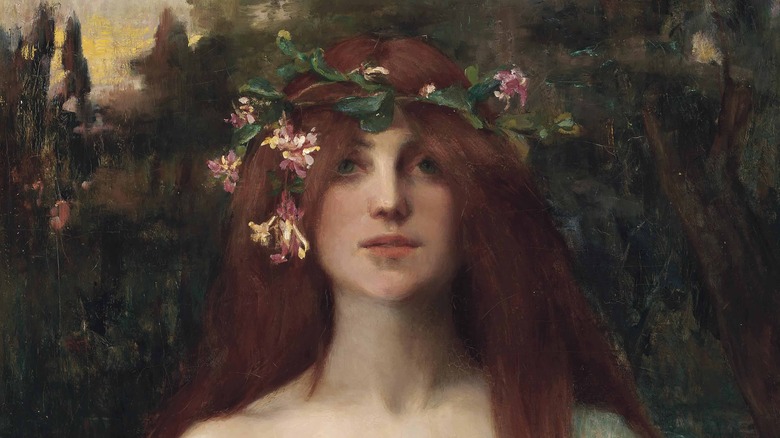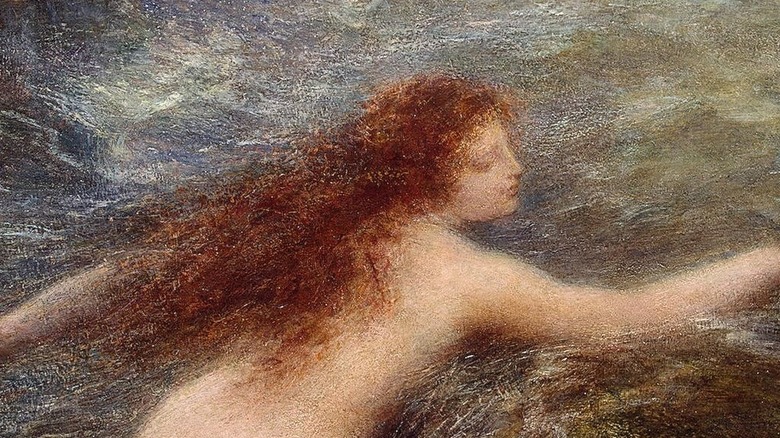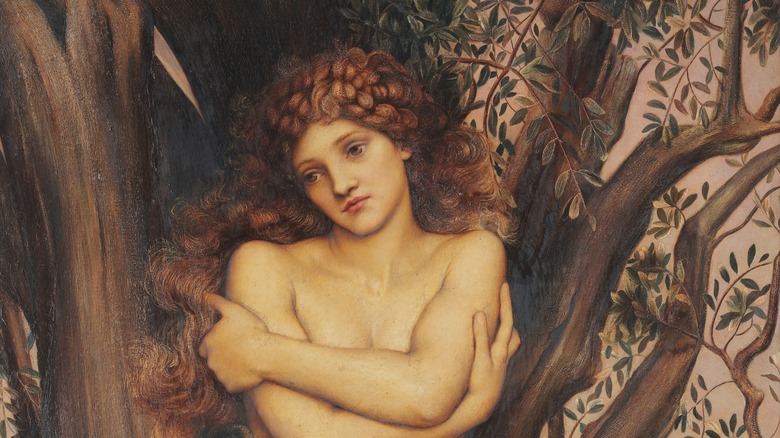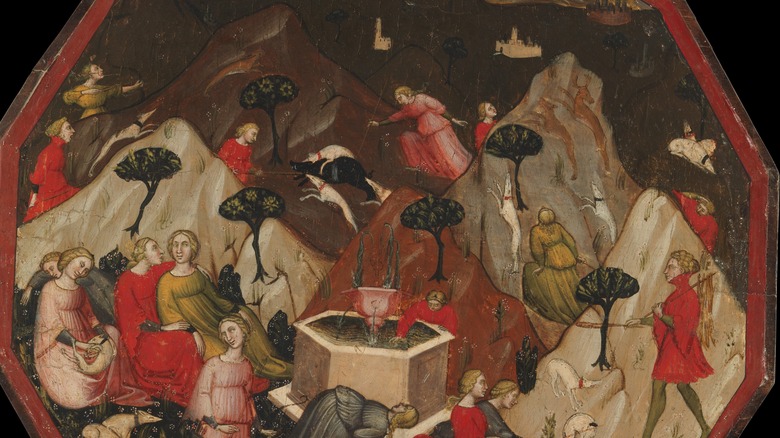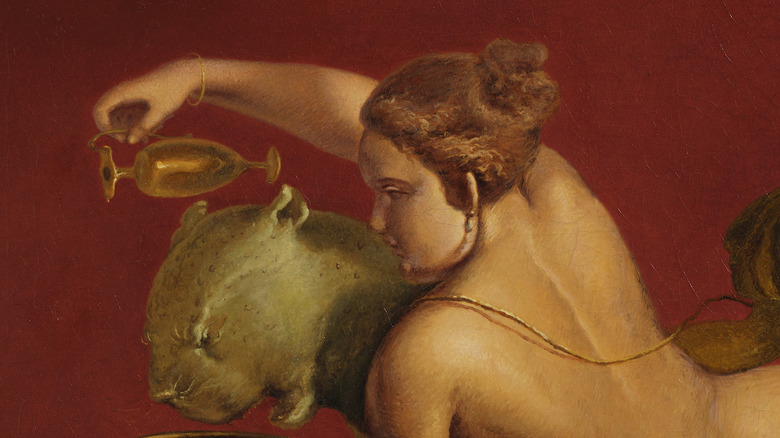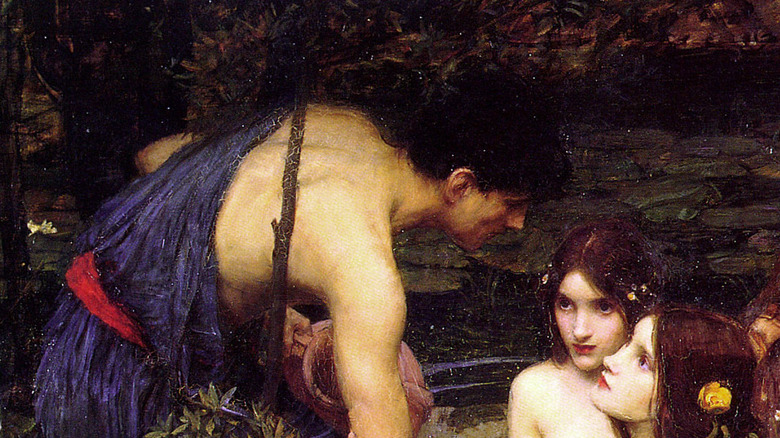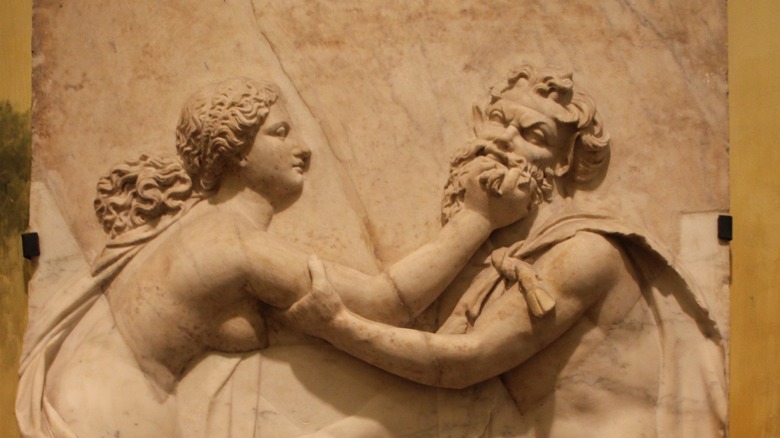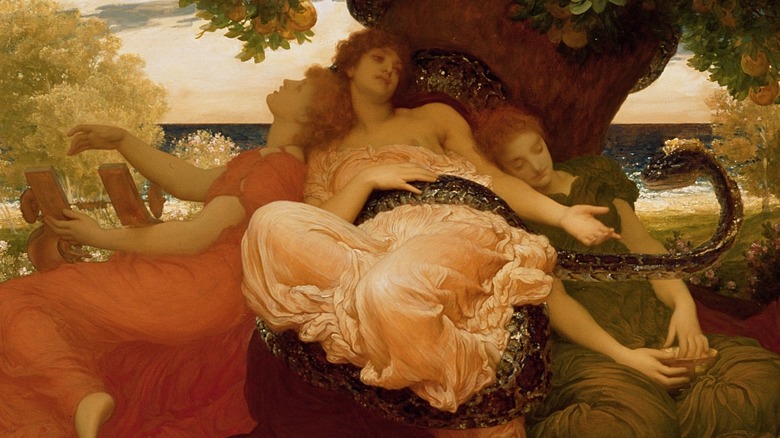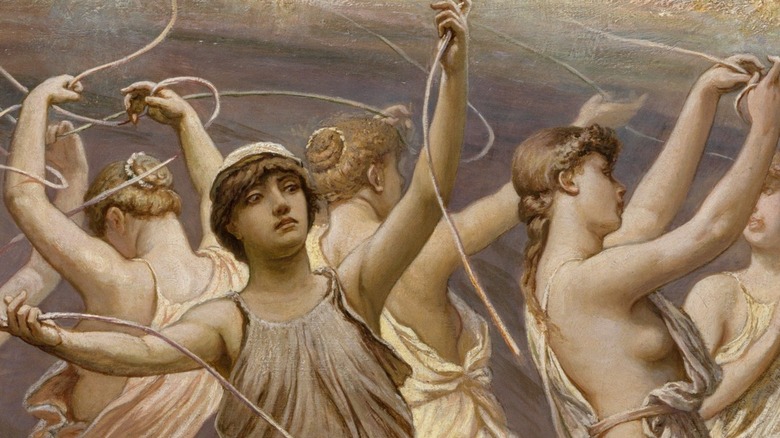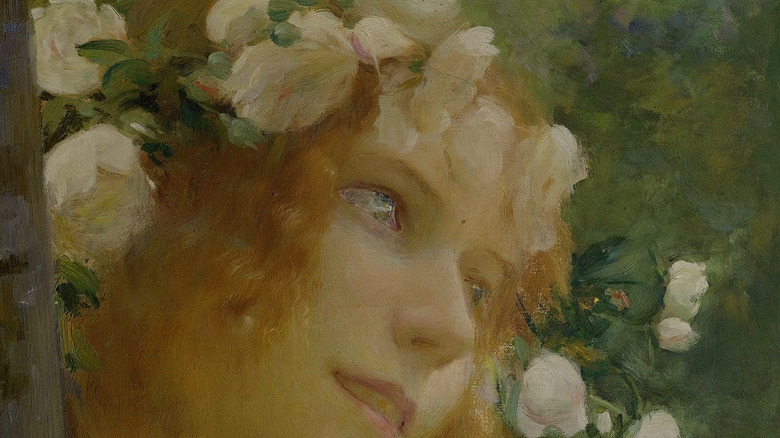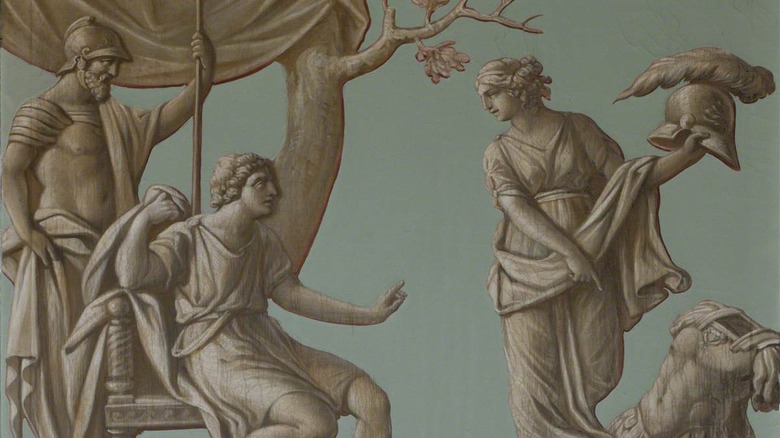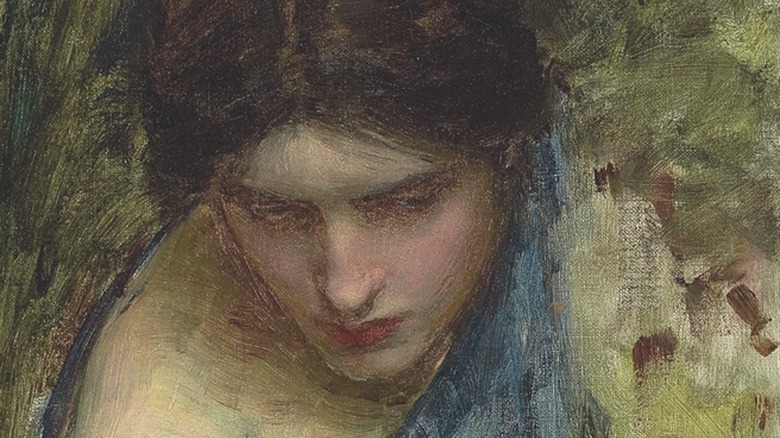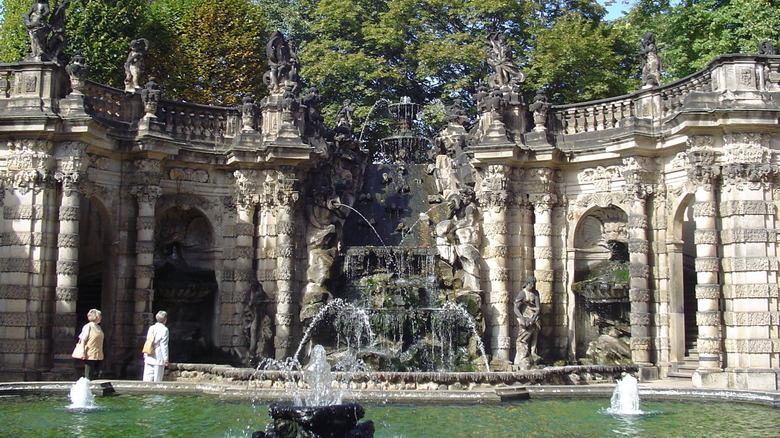The Legend Of Nymphs Explained (& Why They Were So Revered)
Greco-Roman mythology is full of larger-than-life figures, recounting the mighty deeds and mightier foibles of the Olympian gods, the valorous monster-slaying exploits of semi-divine heroes, and the bravery and tragedy of mighty warriors of the past. But in the midst of all these major players, the stories are populated by nearly innumerable minor figures as well — such as minor nature spirits known as nymphs.
These nymphs, while not the stars that someone like Zeus or Heracles might be, play essential roles in the Classical pantheon, essentially serving as the glue that holds everything together. They fill the forests, hills, and rivers, they attend to the gods, and they birth and nurse many of those bigger-name stars. Some have names, some even have their own stories to tell, and many simply dance around in the background. But just what is a nymph, and why were they so important to the ancient peoples of Greece and Rome?
What is a nymph?
As Britannica explains, the term "nymph" was used to describe a broad category of minor female deities in Greco-Roman mythology. Their roles were almost exclusively associated with nature, with the nymphs themselves representing the divine spirit of trees, mountains, and groves, but especially sources of water like lakes, rivers, or the sea. Unlike the gods of Olympus, however, the nymphs were not immortal, though they did live lives far longer than mortal humans. According to Theoi, because of their supernatural tie to nature, they were frequently depicted as the retinues of gods closely associated with nature and the wilderness, such as Artemis (goddess of the hunt), Dionysus (god of wine and fertility), Poseidon (god of the sea), and Hermes (god of shepherds). They were also exclusively female, though they had male counterparts in the forms of satyrs and pans (for the wood nymphs), potamoi or river gods (for the freshwater nymphs), and tritons (for the sea nymphs).
The Online Etymology Dictionary explains that the word "nymph" comes from an Ancient Greek word that originally meant bride, but then came to mean any beautiful young woman before being more broadly applied to these nature deities that look like beautiful young women. From its earliest meaning of bride, it is most likely related to the English words nuptial and nubile, but its meaning as beautiful young woman more directly ties it to the somewhat distasteful words nymphette and nymphomania.
Dryads: nymphs of the woods
One of the larger subclasses of nymphs was the wood nymphs, or Dryads, who were the spirits of the various trees that filled the forests, mountain glens, and riversides. Dryads were frequently separated into even further subclasses based on the kind of tree they inhabited or where they could be found. For example, Theoi lists the Meliae (nymphs of ash trees), the Meliades (nymphs of apple trees), and the Daphniae (nymphs of laurel trees) as some of the specific types of Dryads found throughout myth. One of the more prominent types of Dryads was the Hamadryad, which was typically associated specifically with oak and poplar trees, as well as the banks of rivers and groves dedicated to gods. In some stories, the life of the Hamadryad is tied to the life of the individual tree their spirit was connected to; as long as the tree was healthy, so was the Dryad, but as soon as the tree died, well, you can guess.
Theoi likewise explains that the Meliae is specifically named by the poet Hesiod in his work "Theogony," which recounts the creation of the cosmos, as being born after the Titan Cronus castrated his father Ouranos and threw his bits across the Earth. The blood that dripped down impregnated Gaea, and from this gory affair were born the ash-nymphs, as well as giants and the Furies.
Oreads: nymphs of the mountains
One of the larger categories of wood nymphs is the Oreads, or mountain nymphs. As Theoi explains, in rocky Greece, the majority of forests would have been situated on mountainsides rather than broad, flat plains since any sufficiently large flat space would be used for farming. It makes sense, then, that the ancient Greeks would associate the mountains with forests. Oreads were also sometimes called Orodemniades, and both names derive from the Greek word for mountain. However, it was not uncommon for these mountainside nymphs to sometimes be given names derived from the specific mountains on which they resided, such as the Cithaeronides (from Mount Cithaeron), the Peliades (from Mount Pelion), and the Idaeae (from Mount Ida).
Some of the more famous Oreads of myth include Echo, who was cursed by Hera only to "echo" what others said and wasted away into only a voice; Chelone, who Hermes turned into a tortoise when she skipped Zeus and Hera's wedding; and Pitys, who Pan turned into a pine tree when she ran away from his love pursuit. Maybe the best known, however, is Eurydice, an Auloniad (nymph of mountain glens) who died on her wedding day to the musician Orpheus. Orpheus traveled to the Underworld to save her but lost her forever when he couldn't keep from looking back at her as they were emerging back into the world of the living.
Nereids: nymphs of the sea
As the Encyclopedia Mythica explains, the broader category of sea nymphs was known as Haliae, but these were rarely discussed in favor of a smaller subgroup of sea nymphs known as the Nereids. As the name implies, the Nereids were the daughters of the sea god Nereus and his wife Doris. While the Oceanids were said to be the nymphs of the ocean (conceived of as a great river that encircled the world), the Nereids were the spirits of the water that was literally central to life for the Greeks and Romans: the Mediterranean Sea. The Nereids were 50 in number, with names like Galatea, Glauce, and Psamathe. They are frequently depicted in both art and poetry as accompanying the sea god Poseidon, riding dolphins or sea horses, and the sight of them was supposed to be good luck for sailors.
Among the Nereids, perhaps the most famous is Amphitrite, who is the wife of Poseidon and therefore essentially queen and goddess of the sea. She is usually distinguished in art by wearing a net in her hair and a crown made of crab claws. The other most notable Nereid is Thetis, who was forced against her will to marry the mortal Peleus, as the gods feared a prophecy that her son would be greater than his father. That son turned out to be Achilles, the greatest of the Greek warriors at Troy.
Naiads: nymphs of fresh water
While the Nereids dwelt in the Mediterranean Sea and the Oceanids in the ocean, there were of course nymphs who protected sources of fresh water as well. As Theoi explains, these were called the Naiads, and there were as many subgroups of Naiads as there are sources of fresh water. Pegaeae were the spirits of springs, Crenaeae of fountains, Potameides of rivers, Heleionomai of marshes, and so on. Naiads worked together with the goddess Artemis as protectors of young girls, dedicated to guiding their development into adulthood. (Before your men's rights sense starts tingling, boys were protected by Artemis' brother Apollo and the Potamoi, or river gods.) They are often depicted in art as sitting or reclining next to a source of water and holding a water jug or piece of greenery.
There are a number of individual Naiads whose names are known from myth, often thanks in part to their being desired by gods. For example, the river nymph Daphne was transformed into a laurel tree when she rejected Apollo's advances, and Syrinx became the reeds that Pan makes his eponymous pipe from when she refused him. Naiads also frequently appear as the nurses of young gods, such as the Lamides who raised Dionysus, and the Asterionides, the river nymphs who nursed Hera. On the somewhat darker side, there were the Naiads of Mysia who abducted the handsome young Argonaut Hylas when he went to get water for the ship.
Lampades: nymphs of the Underworld
Anywhere there was life, nymphs could be found, according to Greco-Roman belief. But it turns out there were nymphs even where death reigned supreme. According to Theoi, there was a category of nymphs known as the Lampades, or Lamp-Bearers, whose job was to accompany the infernal goddess of witchcraft Hecate on her nocturnal revels, in a sort of hellish echo of the torch-carrying attendants of the Eleusinian Mysteries that celebrated the goddess Demeter. The Lampades were known by the Romans as the Nymphae Avernales, or the Nymphs of Avernus, which is a name for the Underworld itself.
As the Encyclopedia Mythica explains, possibly the most famous of the Lampades was Orphne, who was married to the god of the infernal river Acheron. Together they had a son named Ascalaphus, whose job was to tend to the orchards of the Underworld. When Hades kidnapped the goddess Persephone to be his wife and she was told she could leave as long as she hadn't eaten any food there, Ascalaphus was the one who snitched that she ate pomegranate seeds, which meant she had to stay part of the year there. Persephone's mother Demeter changed him into an owl for this offense. Although technically a river nymph, another famous nymph of the Underworld was Minthe, who Hades fell in love with, causing a jealous Persephone to transform her into the mint plant, which was named after her.
Hesperides: nymphs of the West
As there were nymphs of the land and sea, rivers and lakes, mountains, and even the Underworld, it will likely not in the least surprise you that there were nymphs of the sky as well. Theoi tells that there were the Nephelae, who were the spirits of rain clouds, the Aurae, who tended to the breeze, and Asteriae, who kept the stars burning. But perhaps the most famous group of such celestial nymphs were the Hesperides, who lived far on the western edge of the world and were responsible for the sunset. In addition, their primary job was taking care of the golden apple-growing tree in their garden that had been the wedding present for Zeus and Hera from Mother Gaea herself. Their main source of help in this endeavor was Ladon, a dragon with 100 heads who was later killed by Heracles when he was tasked with retrieving some apples from the tree. After this, he was placed in the sky, where he became the constellation Draco.
The parentage of the Hesperides is not consistent from source to source. Sometimes they are the daughters of the primordial beings Nyx and Erebus, sometimes Zeus and Themis, and sometimes Hesperis and the Titan Atlas. Atlas was at least associated with the garden of the Hesperides, as it was here that he stood at the edge of the world and held the sky on his shoulders.
Pleiades, the Seven Sisters
Another famous group of nymphs known by a name that is, like the Hesperides, associated with both Atlas and stars is the Pleiades. As the Encyclopedia Mythica explains, the Pleiades were the seven daughters of Atlas and Pleione (although there are of course other accounts), and the sisters of the Hyades, a group of nymphs who were turned into stars after they couldn't stop crying when their brother Hyas died in a hunting accident. They thereafter became a constellation associated with the rain, which can be interpreted as their tears. The Pleiades themselves were also changed into a star cluster out of grief. In some versions, it was because they were sad that their sisters the Hyades were now in the sky, but in others, it was out of grief for their father Atlas being changed into a mountain by the hero Perseus via Medusa's head.
A different tale says that the Pleiades were companions of Artemis who were pursued by the lusty hunter Orion, but in a bid to preserve their virginity, they prayed to be transformed first into doves, and then into stars. Out of the seven sisters, six never married human husbands, but the last, who is sometimes given the name Sterope and sometimes Electra, did the deed with a human man and was consequently shamed into invisibility. This is why only six of the seven sisters are visible in the night sky (and the Subaru logo).
Attendants of divine retinues
According to the World History Encyclopedia, in addition to being the protective deities of the various elements of nature, the nymphs are frequently depicted in art and story as making up the entourages of various gods of nature and fertility, including most prominently Apollo, Dionysus, Pan, and especially Artemis. Artemis in particular was singled out as the divine protector of all nymphs, and her hunting party was made up of wood and water nymphs who, like her, were dedicated to preserving their chastity. Theoi explains that Poseidon was generally seen in the company of Nereids, Hecate with the Lampades, and Persephone with a group of Oceanids called the Leimonids.
Perhaps the most notable divine retinue, however, is that of Dionysus, which as the Encyclopedia Mythica explains contained way more than just nymphs, including Sileni, Pans, centaurs, and wild animals like tigers and panthers. But his most notable followers were the Maenads — also called Bacchae, Bacchantes, Bassarides, and a host of other names — who served as his female attendants, typically characterized by their wild nature, thrashing about in the grip of wine-fueled madness and wielding thyrsi, the holy pine cone-tipped, ivy-entwined staff of Dionysus. These maenads could be Dryads, Naiads, or Oreads, or even human women, such as Agave, the mother of the Theban king Pentheus, who ripped her own son to pieces in bacchic fury when he outlawed the worship of Dionysus in Thebes.
Mothers of heroes and gods
Besides protecting nature and dancing around the woods with various gods, the main role of nymphs in many mythological stories seems to be giving birth to gods and semi-divine heroes. A number of the most famous names in Greco-Roman myth have a nymph as a mother, and a lot of times that's the only thing that particular nymph is known for. As mentioned before, the Nereid Thetis was the mother of the Greek warrior Achilles, though she plays a greater role in myth than many other nymphs. Theoi has a list of many of the nymphs known by name from mythology, which includes Merope, an Oceanid whose son Phaethon by the sun god Helios recklessly drove the chariot of the sun and created the Sahara Desert. There's also Pluto, a mountain nymph who was the mother of the wicked king Tantalus, who is eternally punished in the Underworld. And even the great poet Homer is said to have had a nymph for a mother.
But it's not just humans and demigods who have nymph mothers. A surprising number of relatively major gods are the children of nymphs. The most famous of these is probably Hermes, whose mother was Maia, one of the Pleiades, and whose father was Zeus. Hermes, likewise, fathered the god Pan with either the Dryad Penelopeia or the Oread Sose. Prometheus, Iris, the Graces, and even Aphrodite in some versions all had nymphs for mothers.
Nymphs of specific places
While most classes of nymphs gain their names from their sphere of influence, some nymphs are known by a title derived from the specific place where they are known to live. In many cases, these names also reflect the nymphs' parentage, because if they are the nymphs of a particular river, for example, that river has a god who is probably also the father of those nymphs. Theoi gives as an example the Amnisiades, who were the daughters of the river god Amnisos on the island of Crete. Likewise, the three Asterionides — Euboea, Prosymna, and Acraea — were the daughters of the river Asterion in Argos and served as the nurses of the goddess Hera when she was an infant. Other nymph groups of this type include the Inachides of the river Inachus; the Ogygian nymphs who attended the goddess Calypso on the mythical island of Ogygia; and the Nysiads of Mount Nysa, one of several reported groups of nurses of the infant Dionysus.
Another such group is the Pelionides, a group of nymphs who lived on the slopes of Mount Pelion in northern Greece, whose job was to nurse centaurs, all of whom were birthed by the cloud nymph Nephele. They also raised Aristaeus, the son of Apollo and god of beekeeping who was indirectly responsible for the death of Eurydice. One of them, Chariclo, became the wife of the wise centaur Chiron, the mentor of heroes.
How to worship a nymph
As the World History Encyclopedia explains, before the celebration of nymphs throughout Greco-Roman culture and mythology, the evidence seems to suggest that nymphs were primarily worshiped by the poor, especially those who lived outside of the city. This concept probably makes more sense when you think of how many nymphs are the deities in charge of fresh water sources, which would be incredibly important for such people. Given how capricious water supplies can be, keeping such deities propitiated would have been a major concern. As such, the rural poor would have left sacrifices at fountain shrines for nymphs, something that evolved into the widely-known practice of throwing coins into fountains.
According to Britannica, the common shrine to water nymphs in the Classical era and beyond was known as a nymphaeum, which would have originally been made from a naturally occurring grotto or stream, but which later became highly ornate artificial fountains and other types of public waterworks. These nymphaea would be full of carvings, flowers, mosaics, paintings, and other types of ornamentation. In a tie to the etymological roots of the word nymph, nymphaea were very common locations for weddings, such as the famous Nymphe on the Acropolis in Athens. The nymphaeum remained a common element of Italian gardens throughout the Christian period and well into the Renaissance. Dozens of ancient nymphaea or their remnants can still be seen today in Rome alone.
